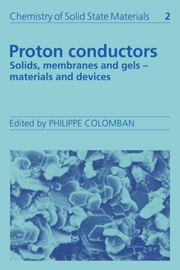Book contents
- Frontmatter
- Contents
- List of contributors
- Preface
- Symbols
- I HYDROGEN BOND AND PROTONIC SPECIES
- II MATERIALS: PREPARATION, STRUCTURES AND PROPERTIES
- 7 Structure and characterization of hydrogen insertion compounds of metal oxides
- 8 High temperature proton conductors based on perovskite-type oxides
- 9 Highly ionic hydroxides: unexpected proton conductivity in Mg(OH)2 and homologues
- 10 Ice
- 11 Anhydrous materials: oxonium perchlorate, acid phosphates, arsenates, sulphates and selenates
- 12 Hydrogen behaviour in graphite–nitric acid intercalation compounds
- 13 Proton-containing β- and β″-alumina structure type compounds
- 14 Proton conduction in zeolites
- 15 Proton containing NASICON phases
- 16 Phosphates and phosphonates of tetravalent metals as protonic conductors
- 17 Hydrogen uranyl phosphate, H3OUO4PO4. 3H2O (HUP), and related materials
- 18 From crystalline to amorphous (particle) hydrates: inorganic polymers, glasses, clays, gels and porous media
- 19 Perfluorinated membranes
- 20 Mixed inorganic-organic systems: the acid/polymer blends
- III PROTON DYNAMICS AND CHARGE TRANSPORT
- IV PROTON DIFFUSION MECHANISMS
- V DEVICES
- Index
17 - Hydrogen uranyl phosphate, H3OUO4PO4. 3H2O (HUP), and related materials
Published online by Cambridge University Press: 04 May 2010
- Frontmatter
- Contents
- List of contributors
- Preface
- Symbols
- I HYDROGEN BOND AND PROTONIC SPECIES
- II MATERIALS: PREPARATION, STRUCTURES AND PROPERTIES
- 7 Structure and characterization of hydrogen insertion compounds of metal oxides
- 8 High temperature proton conductors based on perovskite-type oxides
- 9 Highly ionic hydroxides: unexpected proton conductivity in Mg(OH)2 and homologues
- 10 Ice
- 11 Anhydrous materials: oxonium perchlorate, acid phosphates, arsenates, sulphates and selenates
- 12 Hydrogen behaviour in graphite–nitric acid intercalation compounds
- 13 Proton-containing β- and β″-alumina structure type compounds
- 14 Proton conduction in zeolites
- 15 Proton containing NASICON phases
- 16 Phosphates and phosphonates of tetravalent metals as protonic conductors
- 17 Hydrogen uranyl phosphate, H3OUO4PO4. 3H2O (HUP), and related materials
- 18 From crystalline to amorphous (particle) hydrates: inorganic polymers, glasses, clays, gels and porous media
- 19 Perfluorinated membranes
- 20 Mixed inorganic-organic systems: the acid/polymer blends
- III PROTON DYNAMICS AND CHARGE TRANSPORT
- IV PROTON DIFFUSION MECHANISMS
- V DEVICES
- Index
Summary
Introduction
Uranyl phosphates and arsenates appear interesting as uranium ores. There are about 200 known uranyl phosphate containing minerals which can be divided into three groups according to the UO2/PO4 ratio. The first group with UO2/PO4 = 1 comprises autunites and uranium phosphate micas; the second has UO2/PO4 > 1, most frequently 3/2 and 4/3, and is illustrated by phospharanglite; the third with UO2/PO4 < 1 is represented by parsonite. The first group of minerals contains usually Cu, Mn, Fe and H while in all groups Pb, Ca and Al are present. The formulae of these minerals have not been established accurately and errors in the determination of the UO2/PO4 ratio often lead to incorrect descriptions. Among the above minerals autunite, CaUO2PO4. 3–6H2O, appears to be the most extensively studied.
As far as hydrogen uranyl phosphate (HUP) is concerned, Beintema noticed – as early as 1938–that ‘true vagabond ions are present in the water layer of the structure’. Thirty years later, Sugitami et al. concluded on the grounds of NMR measurements that water molecules in KUO2PO4.3H2O are highly mobile. Much the same conclusions were reached by Wilkins et al. who observed a high mobility of oxonium ions in H3OUO2AsO4.3H2O. Thus oxonium and water protons diffuse rapidly in the structure of uranyl phosphate or arsenate. In spite of the experimental evidence the question of the true and bulk conductivity has been discussed for a long time.
- Type
- Chapter
- Information
- Proton ConductorsSolids, Membranes and Gels - Materials and Devices, pp. 254 - 271Publisher: Cambridge University PressPrint publication year: 1992
- 1
- Cited by



